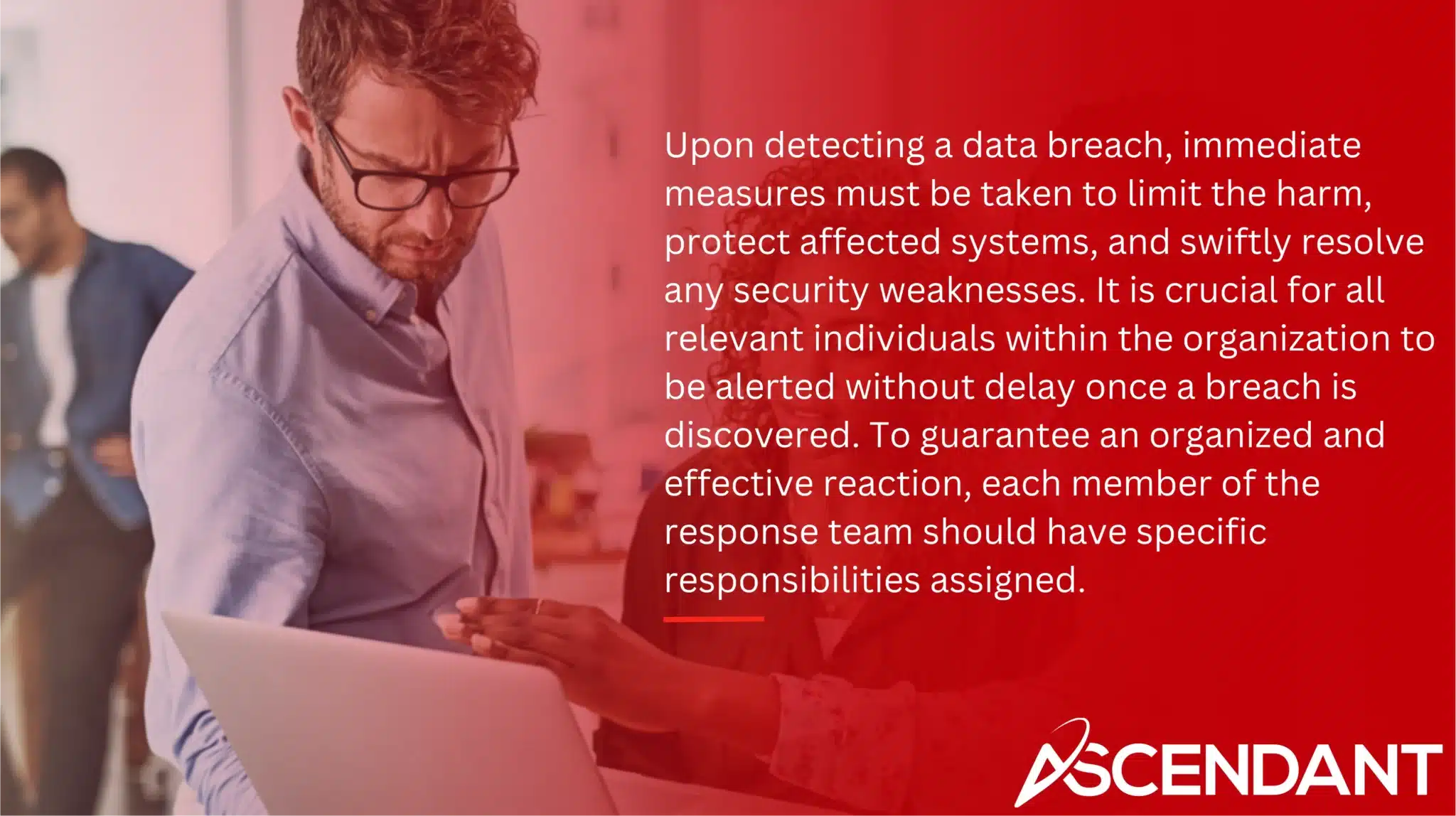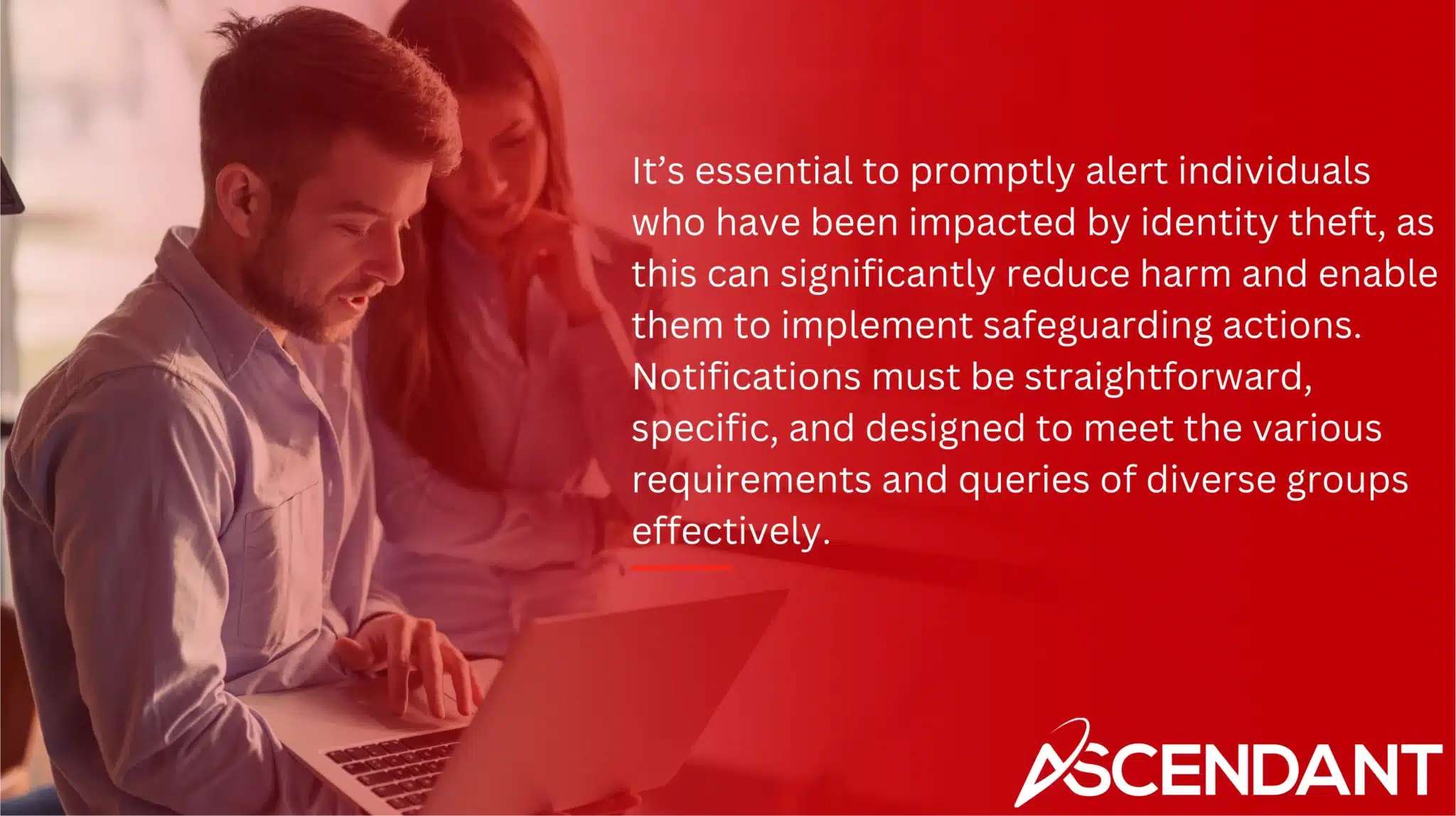Effective data breach investigation is essential when a breach occurs. This guide covers recognizing a breach, gathering evidence, analyzing the event, and creating a response plan. Proper investigation minimizes damage and strengthens your organization’s security.
In This Article:
- Understanding Data Breaches
- Signs of a Data Breach
- Immediate Actions When a Breach Occurs
- Forming a Data Breach Response Team
- Gathering Evidence
- Analyzing the Data Breach
- Containment and Eradication
- Notification of Affected Individuals
- Post-Incident Review and Improvement
- Legal and Regulatory Considerations
- Developing a Data Breach Response Plan
- Training and Awareness
- The Role of Cyber Insurance
- Working with External Experts
- Monitoring and Continuous Improvement
Key Takeaways
- Data breaches expose sensitive information and can lead to significant financial losses, legal repercussions, and long-term damage to reputation and customer trust.
- Recognizing early signs of a breach, such as unusual network activity and unauthorized access attempts, is critical for swift action to minimize damage.
- A comprehensive data breach response plan, including clearly defined roles and responsibilities within a specialized team, is essential for effective incident management and recovery.
Understanding Data Breaches
An incident of unauthorized access to confidential data by nefarious actors defines a data breach. Such breaches can happen through numerous conduits, including but not limited to schemes perpetrated by an internal traitor, cunning social engineering tactics, or exploiting weaknesses in software systems. These security violations carry significant consequences that permeate the entirety of an enterprise. They often entail steep financial costs, as evidenced by the staggering average price tag of $4.35 million for a single breach within the United States alone. Monetary loss is just one aspect. Legal complications, reputational harm and erosion of consumer confidence are among other serious repercussions.
With roughly 28% of organizations susceptible to these invasive acts, there’s a pronounced need for stringent safeguards surrounding data protection to be put into place and maintained vigilantly. The aftermath wrought once sensitive information has been compromised extends beyond simple economic detriment—it encompasses potential judicial proceedings with associated settlements and fines along with regulatory sanctions.
The resulting damage inflicted upon organizational productivity levels coupled with possible degradation in standing amongst clients—and their corresponding satisfaction—has enduring effects on business viability moving forward: it becomes evident why possessing a strategically devised response plan tailored towards addressing instances when such compromises manifest is absolutely imperative for companies today.
Signs of a Data Breach
Detecting the early symptoms of a data breach can substantially lessen its impact. Key signs to watch for include anomalous network activity or user behaviors like unanticipated surges in system access or repeated password requests. An increase in phishing attacks aimed at staff members is often an indicator that occurs before or during a breach, suggesting an elevated danger level. Diminished performance of systems may be indicative of cyberattacks consuming your resources.
Immediate concerns should arise from attempts to gain unauthorized entry, such as the appearance of unfamiliar user accounts. Likewise, any unforeseen alterations to data—ranging from files disappearing to inexplicable edits—are strong indications that sensitive information might have been compromised. By acknowledging these indicators promptly, organizations are empowered to take swift action and protect their sensitive information before extensive harm ensues.
Immediate Actions When a Breach Occurs

Upon detecting a data breach, immediate measures must be taken to limit the harm, protect affected systems, and swiftly resolve any security weaknesses. It is crucial for all relevant individuals within the organization to be alerted without delay once a breach is discovered. To guarantee an organized and effective reaction, each member of the response team should have specific responsibilities assigned.
It’s essential to meticulously record every action undertaken while probing into the breach in order to preserve evidence. Acquiring extensive information right after discovering a breach is imperative. A prompt notification to law enforcement can significantly contribute to improving the investigation’s impact.
By following these procedures diligently, organizations are able to effectively handle the initial consequences that follow a data compromise.
Forming a Data Breach Response Team
The efficacy of managing a data breach relies heavily on the swift actions of the response team. It’s essential for organizations to establish a dedicated group tasked with overseeing the breach response. This unit should bring together critical sectors such as IT, Human Resources, Legal, Communications, Compliance, and Executive leadership to address security incidents and handle subsequent inquiries effectively. By clearly defining each member’s duties in advance, one can avoid unnecessary delays when responding to an incident.
The capability of a data breach response team is contingent upon their preparedness and ability to coordinate smoothly among themselves. Establishing defined roles allows members to respond promptly and decisively whenever confronted with a security incident.
An examination into the specific roles held by team members sheds light on how they collectively contribute towards an effective functioning during data breaches or related incidents.
Key Roles in the Response Team
A proficient incident response team usually includes roles like:
- A Team Lead, who oversees the whole data breach response and defines its overarching strategy
- An Engineering Lead, charged with the technical components of the breach response
- Subject Matter Experts, providing vital specialized knowledge crucial for identifying and solving specific issues within an incident
- A Communications Manager, tasked with managing both internal and external communication throughout a data breach
These clearly outlined roles enable teams to tackle incidents with heightened efficiency.
The Communications Manager is responsible for overseeing information dissemination inside and outside of the organization during a data breach. The team might incorporate experts in forensics analysis, legal matters, information security policies, and IT operations to comprehensively address all aspects linked to a data mishap.
Skills such as legal counsel expertise are pivotal for these teams. Ensuring that your company has access to knowledge in areas including but not limited to forensic investigation techniques or press relations can be indispensable when handling incidents so as to minimize potential harm effectively.
Responsibilities of the Response Team
Having specific roles assigned to the response team is crucial for handling a data breach incident with efficiency. By interviewing employees, one can reveal shortcomings in procedures that may have contributed to the breach occurring. It is also vital to maintain vigilant oversight of vendor security measures continuously, given that third-party vendors often pose substantial risks.
Performing these duties promptly and comprehensively greatly improves the strategy employed for responding to breaches. When each member of the team has a clear understanding of their responsibilities and carries them out effectively, it enables an organization to adeptly confront and lessen the repercussions of a data breach.
Gathering Evidence
Assessing evidence is a vital component of responding to a data breach. Accumulate details regarding the incident, focusing on when it was detected and who reported it. To avoid compromising potential forensic evidence, carefully assess affected systems as you collect this information. It’s important to draw from various sources for your data gathering efforts, such as network devices and testimonials from staff members.
For an in-depth evaluation post-incident, meticulously record all steps undertaken throughout the probe into the breach. Scrutinize access logs to uncover any instances of unauthorized entry related to the timing of the breach. Employing forensic analysis tools can provide a more profound understanding concerning tactics utilized by perpetrators during the commission of a data breach.
Constructing an event chronology is crucial for identifying precisely when a breach transpired. Classifying compromised information aids in discerning which portions of sensitive data require heightened protection measures within your response plan.
Analyzing the Data Breach
The aim of diving into a data breach is to ascertain the specifics surrounding the incident. Contributing to the investigation of such a breach entails responding to various queries. During evidence collection, one should accumulate data from sources like cybersecurity instruments, servers, network hardware, and discussions with staff members.
Undertaking an investigation into a data breach requires adherence to methodical procedures that involve close scrutiny of all collected information. Such in-depth examination provides insights regarding how expansive the breach was, techniques deployed by intruders, and weaknesses they leveraged.
By rigorously analyzing details pertaining to the data breach incident, entities can craft potent measures designed for averting similar occurrences down the line.
Containment and Eradication
Containment and eradication are critical phases in the data breach response process. Isolate affected systems immediately to prevent further data loss. Employ emergency patches and adjust access controls as part of containment strategies. The main goal of containment during a data breach is to isolate compromised systems and preserve evidence.
Perform thorough malware removal and system cleanups during eradication. Patch all vulnerabilities to prevent reinfection after a data breach.
Containment, eradication, and recovery are vital for responding to a data breach. Coordinated actions and a consistent approach are key to successful containment and recovery after a data breach.
Notification of Affected Individuals

It’s essential to promptly alert individuals who have been impacted by identity theft, as this can significantly reduce harm and enable them to implement safeguarding actions. Notifications must be straightforward, specific, and designed to meet the various requirements and queries of diverse groups effectively. Companies ought to devise definitive protocols for informing individuals at risk when their personal rights and freedoms face significant threats.
Neglecting swift notification of those affected could lead to legal repercussions, underscoring the importance of adhering strictly to legal mandates. Open and speedy communication supports people in taking appropriate protective steps while preserving their confidence in the notifying entity.
Post-Incident Review and Improvement
Organizations can enhance their future defense strategies by thoroughly evaluating their reaction through a comprehensive post-incident review. These reviews generate practical measures designed to thwart analogous incidents in the future, focusing on honing the security program via an exhaustive exploration of such events.
The assessments conducted during these reviews may reveal weaknesses within the network that were taken advantage of during the breach. It is essential to comprehend every aspect of an incident in order to fully understand its repercussions and mitigate the risk of it happening again.
Activities following an incident include chronicling insights gained and amending the response plan with improvements tailored for handling potential subsequent incidents.
Legal and Regulatory Considerations
Consult legal counsel promptly to navigate laws related to the breach. Consider the legal implications and requirements for notifying affected individuals. Each state mandates notification for breaches compromising personal information. Consult legal counsel to understand federal and state laws relevant to the specific breach situation.
Non-compliance with data breach notification laws can result in legal repercussions and financial penalties. The California Consumer Privacy Act. The Act imposes stringent requirements on businesses regarding consumer data and breaches. The Health Breach Notification Rule requires notifying the FTC and possibly the media if electronic personal health records are compromised.
Developing a Data Breach Response Plan
A data breach response plan delineates the procedures for addressing a cybersecurity incident. Such a plan equips enterprises with the capability to efficiently manage breaches, thereby reducing monetary damages. The formulation of an exhaustive response strategy is crucial in mitigating the impacts of a data breach, which can encompass harm to individuals as well as fiscal and reputational repercussions.
Preparation entails recognizing potential threats, pinpointing key resources, and forming an incident response team adept at managing such events. A detailed communication protocol should be established that outlines when messages will be relayed, defines steps for escalating issues internally, and devises ways to inform those impacted by the breach.
Implementing tactics to curtail the spread of the breach while ensuring ongoing operations are critical elements in maintaining business stability during such incidents.
Training and Awareness
Conduct regular cybersecurity training explaining risks and attack techniques. Fostering a security culture within an organization requires ongoing training, enabling employees to report suspicious activities promptly.
A security-aware culture enhances overall data security effectiveness and reduces the risk of human error leading to data breaches.
The Role of Cyber Insurance
Insurance for cyber liability, also known as data breach insurance, provides protection to businesses against monetary damages resulting from cyberattacks. This type of insurance aids in lessening the financial impact and endorses the procedures for recuperation when a data compromise occurs.
In instances where small enterprises encounter cybersecurity attacks leading to a breach of data, cyber insurance can assist in defraying expenses related to such incidents.
Working with External Experts
Utilizing the services of cybersecurity companies can bolster overall protection by granting entry to specialized knowledge and tools which might be absent in-house. These external entities can refine communication and workflow amidst a breach response, lightening the load for internal staff. Engaging with these firms significantly improves an organization’s swift and adept handling of data breaches.
Forming alliances with outside cybersecurity professionals gives way to cutting-edge technologies and approaches that may not be possessed by in-house teams. Involving forensic specialists when investigating breaches can accelerate pinpointing vulnerabilities and implementing effective fixes. External experts bring invaluable new insights, essential for detecting possible threats and developing strong security strategies alongside business partners.
Monitoring and Continuous Improvement
Ongoing vigilance enables organizations to identify weak spots early on, preventing them from developing into major security breaches. An active stance towards protection requires continuous evaluation and adjustment in order to meet the challenge of evolving and complex cyber threats. Conducting routine risk assessments is crucial for detecting and ranking vulnerabilities that need addressing to improve an organization’s protective measures.
By employing real-time threat intelligence, organizations gain the ability to foresee possible risks and take preemptive action accordingly.
Summary
Handling the intricate challenges of data breaches requires a deep understanding and a seamlessly orchestrated response approach. Identifying signs of an incident, assembling a capable breach response team, and executing comprehensive post-breach analyses are all vital steps in reducing harm and avoiding future occurrences. Promptly informing those impacted by the breach is crucial, as well as ensuring adherence to legal and regulatory standards. Leveraging cyber insurance plays an essential role.
The essence of effective data breach management is rooted in proactive preparation and ongoing refinement. Crafting an elaborate data breach response plan coupled with cultivating a culture geared towards security awareness empowers organizations to bolster their defenses against cyber threats. Bear in mind that experiencing a data incident is not so much an if, but rather a when situation. Preparedness equates to being equipped to safeguard your organization’s critical assets while upholding trust amongst your stakeholders.
 Frequently Asked Questions
Frequently Asked Questions
What is a data breach incident response plan?
A data breach incident response plan is a comprehensive document that provides guidance for IT and cybersecurity teams on effectively responding to serious security incidents like data breaches. It outlines procedures to follow, ensuring a swift and organized reaction to mitigate damage and protect sensitive information.
What are the first steps to take when a data breach occurs?
Respond quickly to enact measures for incident response, ensuring the protection of systems and remediation of any weaknesses while promptly alerting all necessary stakeholders.
Taking such immediate action is essential for effectively lessening the impact of an incident.
Who should be part of the data breach response team?
A data breach response team should consist of members from IT, Human Resources, Legal, Communications, Compliance, and the C-Suite for a comprehensive approach to incident management.
This diverse representation ensures that all critical aspects of a breach are effectively addressed.
How do you gather evidence after a data breach?
In the aftermath of a data breach, it is crucial to meticulously accumulate extensive information regarding the incident, examine the affected systems thoroughly, and employ forensic instruments to chronicle your investigative steps.
Place emphasis on assimilating information from diverse channels to guarantee an all-encompassing grasp of the specifics surrounding the breach.
Why is notifying affected individuals important?
It is essential to alert individuals who have been affected promptly, as this enables them to take immediate defensive measures, which can significantly reduce the possible harm caused by identity theft. By proactively reaching out, these individuals are equipped with the power to protect their personal data efficiently.

